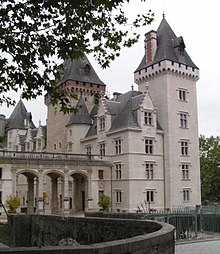Pau Castle
In the center of the old town of Pau im Béarn is the Pau Castle , birthplace of Henry IV , the King of France and Navarre . As a sign of the rule of the “good king”, his image adorns all walls. The castle , which is much older than the unification of the two kingdoms, is, however, also linked to the eventful modern history through the person of Henry IV , who is known as Vert galant (German bon vivant).
The origins
Pau Castle was built in the Middle Ages . In keeping with its military purpose, it has typical castle features . For example, it was built on a hill overlooking the Gave de Pau river .
Since its construction, the castle has also had a symbolic meaning. A palisade of stakes (French: pieux , pau in the Bearnesian dialect ) that surrounded the castle created the metonymy of the reference to the city itself. The stakes symbolized loyalty and sincerity, each one standing like a Bearnesian version of the axis mundi . In the 12th century, Gaston IV of Béarn added three towers to the fortress . They are called Mazères , Billère and Montauser, based on the villages they are based on .
Gaston Fébus
In the 14th century entered with Gaston III. von Foix-Béarn , better known under the name Gaston Phébus , a personality who is emblematic of the Béarn and has left its mark on the castle. Although this warlord was in a delicate position with his possessions on the control surface of the warring kingdoms of France and England, he still managed to make the Béarn, the "gift of God", a united and independent territory. He did this from the center of the region: the castle. Fébus let the 33-meter high castle keep from brick built and there attach the bearnesische inscription: "Febus me fe" (German: "Phebus has made me").
During the Renaissance , the furnishings of the Court of Navarre significantly changed the appearance of the castle. The original fortress became a comfortable residence . Henri d'Albret was the first king of Navarre to settle there; accompanied by his wife Margaret of Navarra , sister of Francis I and author of the Heptaméron . Your initials can be found on the walls and ceilings. They were preserved in the course of restoration work .
Henry IV.
It was her grandson who first made the castle the fame it is today - but not through construction work, not even of his own volition. Henry IV's only merit was to be born there, history did the rest. A turtle shell served as a cradle for this king in childhood , which the Bearnesians had saved from the turmoil of the revolutions, and his fame gave the castle, which saw neither his adolescence nor his death, a special aura. Heinrich IV only became famous after his death in 1610, and his place of birth was forgotten. Only for the signing of the treaty that Navarre under Louis XIII. incorporated into the kingdom of France, the castle was remembered as a historically significant place.
The restoration
Ludwig Philipp , who wanted to reconcile the ideals of the revolution with those of the monarchy , had the idea of restoring the palace and making it a royal residence; after all, its previous owner had already united Catholics and Protestants in peace.
However, it was mainly used as a golden cage for the Emir Abd el-Kader , who had been defeated by France in Algeria . Because the castle was to retain its character from the time of Henry IV, it was furnished with copies of antiques from the Middle Ages and Renaissance to commemorate the splendid age of the “Good King”. Ludwig Philipp could not return from his English exile to this place, which was finally given to Napoléon III. passed over. The portico in the Renaissance style goes back to him, through which one enters the building. It bears the initials of the royal couple of Navarre, who initiated the construction of today's castle.
During the republic the castle became the seat of the president. Today it is a museum and houses various works from the eras since Henry IV and especially from the time of the restoration under Ludwig Philipp.
Web links
Coordinates: 43 ° 17 ′ 41.5 ″ N , 0 ° 22 ′ 30 ″ W.
